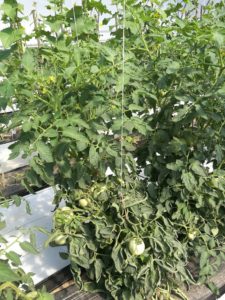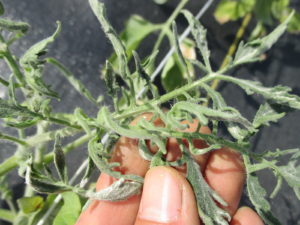We have received several calls recently reporting observations of leaf curling on tomatoes. Although several factors (disease, insect, herbicide, environmental stress etc.) could cause leaf curling, in late spring and early summer, we notice the majority of the leaf curling is caused by physiological factors that in general do not directly affect tomato yield and fruit quality.
In a similar way to other vegetables, hot and dry conditions may cause leaf curling on tomatoes. In late spring and early summer, plants that are actively growing and developing fruit have a high demand for water. Under hot and dry conditions, plants respond by rolling the leaves to reduce the surface area exposed to high radiation. Lower leaves on a tomato plant are often affected first, they may recover if environmental stresses are reduced. But with some varieties, leaf curling may occur on most leaves of a plant and last for the entire season. As we mentioned earlier, leaf curling itself due to the environmental stresses is not a significant concern, but if the stress condition continues, it may eventually lead to blossom end rot fruit and decreased yield. There is a great variation among tomato varieties in terms of whether observation of leaf curling suggest the plant is suffering water stress that may eventually affect yield and quality. But as leaf curling is relatively easy to notice, it would be a good idea to check developing fruit for potential blossom end rot if severe leaf curling is detected.
Excessive nitrogen can also cause leaf curling, and the rolled leaves are often thicker and become dark green. The symptom is often noticed on heavily pruned tomato plants and plants that lose growing points. In Figure 1, the tomato plant was pruned and trellised to be grown with two main leader system. One part of the plant showed significant leaf curl because the growing point of this part of the plant was accidentally removed. As long as there are other growing points remaining, the plant can recover, and the leaf curling will only be a temporary observation.
Except for the margins of the leaves which are rolled up, the leaves generally appear normal for the above-mentioned leaf curling situations. However, if the curling leaves are severely deformed or twisted, herbicide damage may be a concern. In Figure 2., leaf curling is likely caused by a hormone-type herbicide damage (such as 2,4-D and dicamba). The symptom was more pronounced on top of the plants, where new growth occurs. Tomato plants are extremely sensitive to herbicide damage. Depending on the level of the injury, some plants may not be able to recover. There are no remedies for herbicide damage.
Insect or disease damage may also cause tomato leaf rolling. Other symptoms such as mosaic, chlorosis or the signs of the insect itself may accompany with the leaf curling symptom. If you suspect the leaf curling was caused by these biotic factors. Samples should be sent to Plant and Pest Diagnostic Laboratory for pest identification before taking actions.

